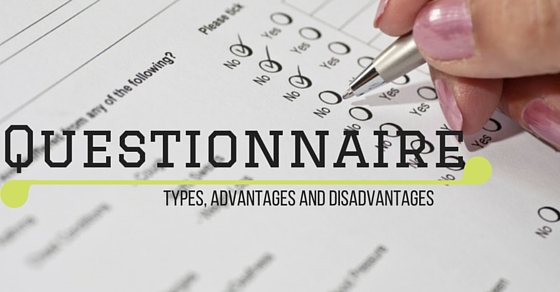Questionnaires have been used since the 19th century. Often used as a method for collecting information, the questionnaire was first developed in London in 1838.
What is a Questionnaire?
A questionnaire can be defined as a set of questions along with answer choices asked for respondents which are mainly used for gathering information or for survey purposes.
Questionnaires are usually used for collecting data from the respondents through a series of questions and other prompts set by the organization conducting such experiments.
Questionnaires are not necessarily statistical data, but they do act as an effective alternative for surveys since they are cheap and can be widely used to reach within people in a short period of time.
These are usually used to get a standardized answer rather than a specific answer seen in other questionnaire types of statistical data collection.

Types of Questionnaires:
Based on the type of questions used, questionnaires are as follows:
1. Structured questionnaire:
Comes under quantitative research. It includes a low number of researchers and the high number of respondents. They are also called as closed questionnaires. They usually include answers such as very bad, bad, good, very good and so on.
- They have a definite and concrete questions
- They have to be prepared well in advance so as to ask as many questions and receive info from the respondent.
- A formal inquiry is initiated.
- Supplements and checks the previously accumulated data.
- Commonly used in for social and economic problems, to study about the changes caused due to change in policies, laws etc.
These question comes under structured questionnaire.
Contingency questions:
This comes under a structured questionnaire. Here a question is asked only if the respondent is able to give an answer to the previous question.
Matrix questions:
A similar kind of option is provided to multiple questions. The questions are provided one under the other, forming a matrix with response categories on top and questions down the side
2. Unstructured questionnaire:
A version of the qualitative survey. They are usually based around more open questions. Open questions also mean recording more data as the respondents can point out what is important for them, in their own words and methods. But it is more difficult from the researcher’s side since it does not give the correct idea of the topic and moreover, a proper understanding of the data is needed.
- Usually used at the time of an interview.
- It doesn’t require much planning and time.
- More flexible for applying in many areas.
- Usually used to collect data about people and their personal info such as family, debates, beliefs etc.
3. Scaled questionnaires:
The respondents are asked to scale the answers based on a given rating prescribed by the question.
Depending on the type of format used in questionnaires, they are divided into the following.
Open format questions:
These are the type of questions that are used to allow the respondents to express their views in a free-flowing manner.
By using such questions, the respondents do not have to follow the criteria for answering questions and he/she can truly express their beliefs and suggestions.
An ideal questionnaire is a type of questionnaire that includes open-ended questions and also has feedback and suggestions for future improvements.
Closed format questions:
Multiple-choice questions come under this category. The user is restricted to answer their opinions through the options that are set by the surveyor. Hence, these are also called as close-ended questions.
One of the main advantages of using closed-ended questions is the ease of doing preliminary analysis. These are usually used to find an opinion about known questions and answers. They are usually used to track the status and the improvements of organizations and companies.
Closed-ended questions are of various types:
1. Leading questions:
These type of questions force a definite type of answer from the audience. In such a question, all kind of answers are equally likely. The answers can vary from bad, very bad to good and very good. These are usually used to collect information from the users in very limited words.
2. Importance questions:
The respondents are asked to take a rating for a certain type of issue on a scale of 1 to 5. This shows how much importance does the questionnaire topics really hold within the company or within the minds of the user.
3. Likert questions:
These questions show how much the customer agrees to a certain topic and how much it impacts the respondent.
4. Dichotomous questions:
These questions ask the respondents only a yes or no answer. Hence, it makes it difficult to analyze beyond the yes and no answer.
5. Bipolar questions:
Such questions have answers that are in the extreme case. The respondents are required to ask to rate the question between these two extremities.
6. Rating scale questions:
In such questions, the respondents are asked to rate a particular issue between the ratings of good and bad. Such questions have even number of choices, so as to prevent selecting the middle option all the time.
7. Buying propensity questions:
These questions are used to rate whether the respondent will again use the service or the product in the future.
4. Hand Delivered Questionnaire:
This type of questionnaire is also called direct questionnaire where the researcher
directly goes to the respondent and shares the questions.
The respondent needs to tick the right answers in front of the researcher
Advantages:
- In this type, the researcher will have a close relationship with the respondents.
- Tough questions are explained by the researcher if the respondents want.
- The reason to study is also described
Disadvantages:
- Expensive
- Time-consuming.
5. Mailed Questionnaire:
This type of questionnaire is mainly used by most of the researchers. Here the respondents would be living somewhere far and the questionnaire is sent to him by post. Along with the questions, a set of instruction list is also sent to him.
The respondent needs to write the answers and send it back to the respective person or agency.
Advantages:
- Most commonly used
- Very helpful for the researcher.
- Time-saving
- Easy and simple.
- Not at all expensive
Disadvantages:
- Lack of returns.
- Time taking if respondents are careless and lazy.
- Scarcity of skilled respondents.
- Chances of Errors due to misunderstanding by respondents.
6. Mixed questionnaire:
- Comprises of both closed and open type of questions.
- Most used in the social research sector.
7. Pictorial questionnaire:
- It is not used regularly.
- Usage of pictures impacts the respondents in answering the questions
- Mostly used for studies based on social attitudes and prejudices in children
Advantages of Questionnaires:
1. Questionnaires are really inexpensive when they are handled properly. They can be cheaper than taking surveys which requires a lot of time and money.
2. Questionnaires can be of different types, written, postal, telephone and many other methods.
3. A single question or a topic can be asked to many at the same time without any kind of delay. Unlike surveys, they don’t have to go to each and everyone to get an opinion.
4. It is an effective method to get an opinion from a large number of people.
5. A large number of respondents can be possible varying in age, sex, occupation, etc.
6. Question responses can be highly defined and specific, depending upon the type of questions asked in the questionnaire.
7. These results can also be included as a statistical survey, the deciding factor is the nature of the questionnaire and on what topic was the questionnaire based on.
8. Unlike face to face surveys where the respondent has to answer within that moment itself, questionnaires give time to the respondents to think carefully, before giving the answers.
9. Questionnaires are easily replicable and can be repeated, and if well-constructed and properly piloted, they can be used as comparative materials for future studies and projects.
10. Standardized questionnaires can already be validated and can be used to compare between works and studies.
11. They are easy to administer and manage.
12. These type of data collection are common among all kinds of professions including teaching and bookkeeping. Questionnaires have become a part of our daily lives.
13. The format for most types of questionnaires is common to the common people irrespective of the status.
14. The most important part of a preliminary survey. Usually taken as a step to collect important data such as feedback, suggestions and constructive criticisms.
15. Questionnaires are usually straightforward in their approach which makes them easier to analyze and compare with the ideal answers.
16. Questionnaires provide a lot for data analysis and data manipulation. The more the data that is received, the more accurate will be the analysis.
17. Questionnaires allow people to answer questions when they feel it is convenient. Thus, it is more applicable than face to face surveys where people are expected to immediately reply to the question.
18. If anonymous, more honest answers can be expected from the people being surveyed.
19. Questionnaires can reduce a lot of bias. Since all the respondents are answering the same number and the same type of questions.
20. Used for getting answers from a large group of people from a short space of time.
Disadvantages of Questionnaires:
1. The results for questionnaires are based only on the type of question being asked. If the questions are poorly worded or are biased in nature, then the result analyzed will also be of the same nature.
2. Questionnaires can pose difficulties to the analyst if he/she is not familiar with the system based on which the questions are being asked. That is, the analyst may not be able to produce the required questions, and hence the required results cannot be achieved.
3. Questionnaires tend to give an alien feeling to many respondents and hence they are very impersonal irrespective of the situation. Thus, many people do prefer face to face conversations than answering questionnaires.
4. The response rate may be poor in questionnaires if people do not have time or they don’t feel any importance in answering them. This is one of the main disadvantages of questionnaires.
5. Questionnaires do make it impossible for people to answer questions according to their own opinion. This makes them very constricted in terms of answering such questions. This feels true, particularly when the questionnaires have closed-end questions. They limit the opinions of the respondent by a huge factor. Hence, less honest and detailed answers can be received.
6. Some participants may forget about the whole issue and tend to forget why such a questionnaire was present in the first place.
7. Open-ended questions may take a long time and will produce a large amount of data that will take time to analyze.
8. Respondents may answer the questionnaire superficially if it takes time to answer such questions. This might lead to inadequate and maybe unwanted data to analyze the final result.
9. Do not try to ask too many questions since it might bore the respondent and ultimately it will lead to incorrect answers.
10. Try to make the questionnaire as anonymous as possible as it will be more beneficial for the respondent to explain their opinions in detail.
11. Try to state the respondents for what purpose is the survey being taken and how the questionnaire will be beneficial in the overall process.
12. For a more fruitful approach, try to make sure that the questionnaire is applicable to individuals who are willing to answer and are ready to give a valid answer.
13. If any doubts in the answers, the analyst cannot trace back to the respondents since most of the questionnaires are usually anonymous in nature.
14. Questionnaires can also give the respondents freedom to lie, hence resulting in vague answers or opinions that are distant from the main issue.
15. If not administered face to face, that is through telephone or such incentives, questionnaires can have low response rates.
16. Questionnaires do not explain the questions to the respondents which might lead to misinterpreted answers and facts.
17. Questionnaires cannot inform about the real meaning and fact of why such data is collected. Hence, this means that the respondents do not feel obligated to answer such questionnaires truthfully and specifically. This leads to misinterpretation of data.
18. People can feel biased to certain questions in a questionnaire. This may be due to the fact that the respondent may be penalized when answering such questions truthfully.
19. Questionnaires provide very little stability with the response processes in taking a survey.
20. Questionnaires may not be suitable for certain people. It may not be suitable for illiterates or people who have reading problems.
21. Especially from postal questionnaires, it might be difficult to obtain a certain number of answers within a limited period of time.
22. Respondents may ignore certain questions without giving a proper answer.
23. Questionnaires can be incorrectly filled.
24. They are not suitable for collecting and taking information about long and complex issues.
25. Because of the ambiguous language used, it might be a bit confusing for the respondent to answer such questions.
26. More than 90% of the questions are in printed or in a visual format in a written questionnaire. Gestures or other visual clues are not present. This can cause problems to which the questionnaire is being requested.
27. Too many frequent questionnaires can cause fatigue among the respondent group and can cause misuse of questionnaires and related surveys.
28. Try to have a simple and intuitive questionnaire format. For example, try to line up response boxes on the right side of the questionnaire so that it is easy for the respondent to mark the options.
29. Try to use easy and understandable vocabulary so that the questionnaire can be understood by all groups of people.
30. Try to make the instructions to the respondents as clear as possible.











































